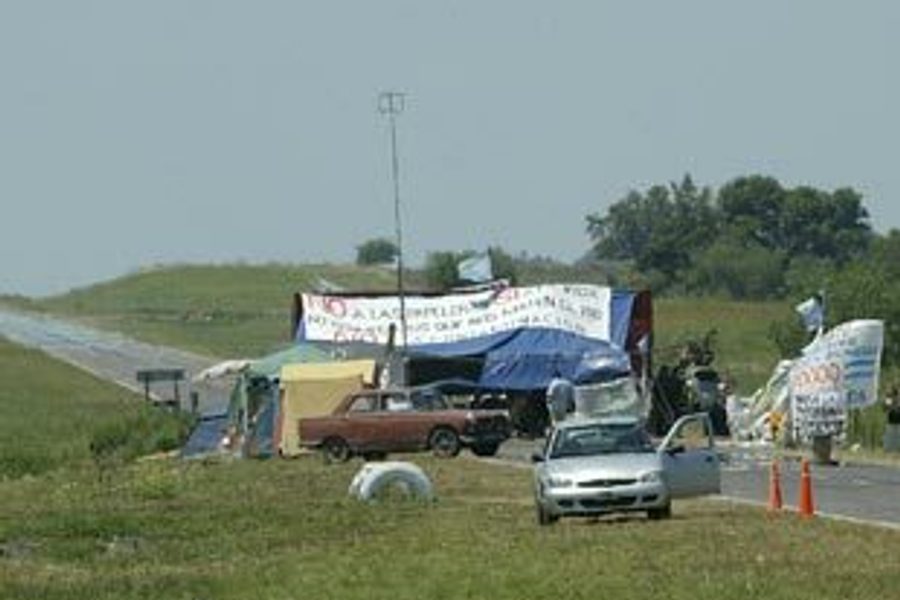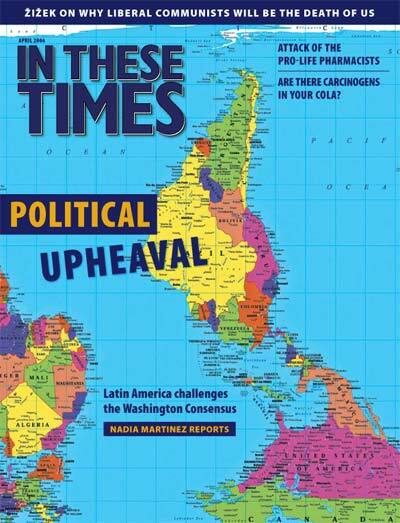Pulp Non-Fiction
A paper mill at the border of Argentina and Uruguay causes massive protests
Kelly Hearn

Stella Maris squeegees rain off International Route 136, a two-lane highway on the border of Argentina and Uruguay, currently blocked by tents, tractors, grain trailers and logs.
“I have been here for 11 days straight,” says the 46-year-old Argentine mother-turned-environmental activist, one of a handful of people camped among soybean fields, cow pastures, pine trees and eucalyptus stands. “I have had to leave behind everything, my job, my kids, everything. I didn’t care at first but then I started listening and realized it was worth it.”
The cause of her new mission is located 10 miles up the road, on the banks of the River Uruguay, a natural border between the two countries. On the Uruguayan side, a Spanish and a Finnish company are building two of the world’s largest pulp mills near a sleepy river port town called Fray Bentos. Supported by Greenpeace and Jorge Busti, the provincial governor here in Entre Ríos, Maris and some 1,500 people from the nearby city of Gualeguaychú, Argentina, are demonstrating against the mills as a looming environmental disaster.
Making paper requires bleaching a brownish pulp with chlorine or chlorine dioxide, both of which cause environmental damage. Though company officials and Uruguay authorities say the plants will use technologies that make it chlorine-free, environmentalists aren’t convinced and believe the plant’s exhaust will cause cancers and kill plants and animals.
In protest, they have blocked Route 136 and another key border crossing, turning back traffic that ranges from tourists to Chilean cargo trucks. The blockade is generating economic tremors in Uruguay, transforming a homespun environmental protest into a regional crisis. Governments are posturing as activists hunker down. Tabaré Vázquez, a popular former doctor and Uruguay’s first socialist president, has called on his Argentine counterpart to force an opening.
Argentine President Néstor Kirchner, a socialist up for re-election next year, balked for weeks. On March 11, however, the presidents made a shaky truce, promising to halt construction of the plants and to lift the blockades for 90 days. As In These Times went to press, the conflict was unfolding by the hour. Gualeguaychú’s protestors were unfazed by the truce and on March 13, La Nación, a popular Argentine paper, reported a potential new twist: Unions at the plants were thinking of taking them over to ensure their jobs weren’t lost.
The presidential agreement was preceded by weeks of diplomatic wrangling. The Kirchner government, with support of the Argentine Congress, had threatened to take the matter before the International Court of Justice at The Hague. For its part, Uruguay sent a delegation to Washington on Feb. 24 to meet with the Secretary General of the Organization of American States (OAS). And Vázquez even threatened to leave Mercosur, a four-nation trading block formed by Uruguay, Argentina, Brazil and Peru, if the free flow of goods and people wasn’t restored.
The $1.9 billion plants represent Uruguay’s largest foreign investment. Spain’s Grupo Empresarial is building a facility to produce 600,000 tons of eucalyptus pulp annually. The facility of Finland’s Oy Mëtsa-Botnia AB and Kymmene Corp will produce one million tons annually.
What’s more, both pulp mill companies have a stake in Uruguay’s booming and controversial monoculture forestry program, which has turned millions of acres into commercial tree plantations with help from World Bank and Uruguayan government subsidies. In 2003 Botnia bought a 60 percent stake in the Uruguayan forest cultivation company, Compania Forestal Oriental, which at the time owned 48,000 hectares of land in the west of Uruguay, of which at least 32,000 hectares contained eucalyptus forest planted on grassland. Likewise, Grupo Empresarial has a stake in the forestry company Eufores, which has at least 40,000 acres of plantation.
Meanwhile, the noose tightens around little Fray Bentos, where not far from the construction zones bony horses munch weeds along rusted railroad tracks and locals sip yerba maté in the town square. Mayor Omar Lafluf says the roadblock has hit hard, but that the plants have already brought in 6,000 construction jobs and plenty of collateral goodies like 300 new houses, an expanded pier, two logistical centers and the major remodeling of a hotel. Other locals at a recent town meeting complained of layoffs and cutbacks, vacant hotel rooms and empty restaurants.
But Martin, a 56-year-old cab driver from Gualeguaychú, stands firm. “We are in the hot zone,” he says. “If they build those plants, the contaminants will be in the river, the air, the animals and the people. It will kill our environment.”
Uruguayan and company officials argue that monitoring and technology will keep things safe. “The pulp mill will not produce any biological impact on the environment,” Bruno Vuan, a Botnia spokesman, wrote in an e-mail. “Botnia has experience in operating pulp mills in Finland, a country with the best environmental ratings in the world. As in Finland, in Uruguay we will apply the best available technologies according with the latest European Union regulations.”
Vuan says Botnia’s mill is slated to be the most modern in the world, and that his company has “carried out detailed environmental studies with the best Uruguayan and Finnish experts, studies that have been reviewed and approved by Uruguayan authorities.”
But Uruguayan authorities aren’t sleeping on Route 136. Those who are say they have been shown no proof of safety precautions and they fear that once the mills start, any related contamination will not be able to be stopped. As a result of the dispute, historically friendly relations are now sliding downhill. One 65-year-old Argentine at the blockade says she has family in Uruguay, and considers the two countries to be brothers. She says the issue is about the environment. But for Erica, 23, a Fray Bentos resident laid off from her job as a shop attendant thanks to the blockade, it’s more personal. She and her family say local Argentines have gotten aggressive, and that Uruguay is too often kicked around by Brazil and Argentina.
Does the recent presidential handshake mean a way out of the impasse? Experts say bilateral talks are the only solution because the OAS will not intervene without a request from both parties in a conflict, and The Hague will not rule on hypothetical claims of future environmental damage.
For now, tensions continue to mount despite the diplomatic overtures. While activists and editorialists pitch suggestions to solve the crisis, the Argentine protesters keep performing as a well-oiled grassroots democracy. Though the number of hardcore, round-the-clock protesters dwindles to as few as a dozen, supporters ferry supplies throughout the day and nighttime crowds still swell to more than 1,000 as families leave work, bring out barbeque and the kids, and meet as the Gualeguaychú Citizens Environmental Assembly. “There is no hierarchy,” says Martin of the assembly. “There are no leaders. It is purely democratic. We come out and we have an agenda for the day, which is usually how long the blockade will last. Then we vote.”
As this day’s assembly closes, the resolve behind those votes suggests that Ms. Maris and her squeegee will still have plenty more time to kill.






